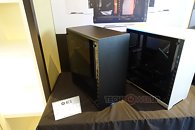Apr 6th, 2025 14:23 EDT
change timezone
Latest GPU Drivers
New Forum Posts
- 9070XT or 7900XT (25)
- What local LLM-s you use? (146)
- How I made an Ultimate Cooling Guide (14)
- RX 9000 series GPU Owners Club (191)
- My computer setup - Request for opinions (29)
- Do you use Linux? (558)
- gpu heirarchy/performance/benchmarks- whos lying? (37)
- dropped my xbox controller, now LB doesn't feel clicky (9)
- I have a bricked XFX Radeon RX 580 8GB GPU. HELP! (11)
- Adventure: Running 8/9th gen Coffee Lake CPUs on Z170 motherboard (ASUS Maximus VIII Ranger) (377)
Popular Reviews
- ASUS Prime X870-P Wi-Fi Review
- UPERFECT UStation Delta Max Review - Two Screens In One
- PowerColor Radeon RX 9070 Hellhound Review
- Corsair RM750x Shift 750 W Review
- DDR5 CUDIMM Explained & Benched - The New Memory Standard
- Upcoming Hardware Launches 2025 (Updated Apr 2025)
- Sapphire Radeon RX 9070 XT Pulse Review
- Sapphire Radeon RX 9070 XT Nitro+ Review - Beating NVIDIA
- AMD Ryzen 7 9800X3D Review - The Best Gaming Processor
- Pwnage Trinity CF Review
Controversial News Posts
- MSI Doesn't Plan Radeon RX 9000 Series GPUs, Skips AMD RDNA 4 Generation Entirely (146)
- Microsoft Introduces Copilot for Gaming (124)
- NVIDIA GeForce RTX 5060 Ti 16 GB SKU Likely Launching at $499, According to Supply Chain Leak (124)
- AMD Radeon RX 9070 XT Reportedly Outperforms RTX 5080 Through Undervolting (119)
- NVIDIA Reportedly Prepares GeForce RTX 5060 and RTX 5060 Ti Unveil Tomorrow (115)
- Over 200,000 Sold Radeon RX 9070 and RX 9070 XT GPUs? AMD Says No Number was Given (100)
- NVIDIA GeForce RTX 5050, RTX 5060, and RTX 5060 Ti Specifications Leak (97)
- Nintendo Switch 2 Launches June 5 at $449.99 with New Hardware and Games (92)
News Posts matching #NEO
Return to Keyword Browsing
Valve Confirms SteamOS is Coming to ASUS ROG Ally, Other 3rd Party Handheld Devices
According to The Verge, Valve confirmed its intention to extend support for its Linux-based SteamOS to rival gaming handhelds, including the ASUS ROG Ally. This move marks a significant step towards realizing Valve's decade-old vision of a widespread "Steam Machine" ecosystem. Lawrence Yang, a designer at Valve, confirmed to The Verge that the company is actively working on adding support for additional handhelds to SteamOS. This revelation came after eagle-eyed observers spotted a curious line in Valve's latest SteamOS 3.6.9 Beta release notes mentioning the addition of "support for extra ROG Ally keys." While the development is still in progress, Yang emphasized that SteamOS isn't quite ready for out-of-the-box use on rival devices. However, he assured that the team is making "steady progress" towards this goal.
This initiative doesn't necessarily mean that manufacturers like ASUS will officially endorse Valve's installer or ship their devices with SteamOS preinstalled. Many companies, including ASUS, have cited various reasons for sticking with Windows, including Microsoft's dedicated validation teams that ensure compatibility across diverse hardware configurations. Other devices, such as Lenovo Legion Go, AYANEO, and GPD Pocket 4, ship with Windows, but it could be interesting to see with SteamOS. Alongside support for third-party handhelds, Valve is also working on a general release of SteamOS 3 for non-handheld PCs. Finally, Valve hasn't forgotten about its promise to enable dual-booting on Steam Deck devices. While there's no specific timeline, Mr. Yang confirmed that it remains a priority for the company. We remain to see how this will materialize, and with added bells and whistles to SteamOS, the adoption of Linux-based gaming could be pushed even further.
This initiative doesn't necessarily mean that manufacturers like ASUS will officially endorse Valve's installer or ship their devices with SteamOS preinstalled. Many companies, including ASUS, have cited various reasons for sticking with Windows, including Microsoft's dedicated validation teams that ensure compatibility across diverse hardware configurations. Other devices, such as Lenovo Legion Go, AYANEO, and GPD Pocket 4, ship with Windows, but it could be interesting to see with SteamOS. Alongside support for third-party handhelds, Valve is also working on a general release of SteamOS 3 for non-handheld PCs. Finally, Valve hasn't forgotten about its promise to enable dual-booting on Steam Deck devices. While there's no specific timeline, Mr. Yang confirmed that it remains a priority for the company. We remain to see how this will materialize, and with added bells and whistles to SteamOS, the adoption of Linux-based gaming could be pushed even further.
NEO Semiconductor to Present Its Ground-Breaking 3D NAND and 3D DRAM Architectures at Flash Memory Summit 2023
NEO Semiconductor, a leading developer of innovative technologies for 3D NAND flash and DRAM memory, today announced its participation at Flash Memory Summit 2023, taking place in person in Santa Clara, California, on August 8-10. CEO, Andy Hsu, will deliver a keynote address titled "New Architectures which will Drive Future 3D NAND and 3D DRAM Solutions" on August 9th at 11:40 a.m. Pacific Time.
Earlier this year, Neo Semiconductor announced the launch of its ground-breaking technology, 3D X-DRAM. This development is the world's first 3D NAND-like DRAM cell array that is targeted to solve DRAM's capacity bottleneck and replace the entire 2D DRAM market. 3D X-DRAM can be manufactured using the existing 3D NAND flash memory process with minor changes, significantly reducing the time and cost spent developing a new 3D process. During the keynote, Mr. Hsu will reveal the 3D X-DRAM process flow and technical details.
Earlier this year, Neo Semiconductor announced the launch of its ground-breaking technology, 3D X-DRAM. This development is the world's first 3D NAND-like DRAM cell array that is targeted to solve DRAM's capacity bottleneck and replace the entire 2D DRAM market. 3D X-DRAM can be manufactured using the existing 3D NAND flash memory process with minor changes, significantly reducing the time and cost spent developing a new 3D process. During the keynote, Mr. Hsu will reveal the 3D X-DRAM process flow and technical details.
Schenker (XMG) Predicts New Laptop Delays Due to Component Shortages
China is reacting to new outbreaks of the Omicron variant of the Coronavirus with partial lockdowns. This could further delay the availability of laptops with 12th Gen Intel Core processors and NVIDIA's Ti graphics cards, which debuted at the beginning of the year. The first factories have already been closed in Suzhou in the east of the country. Supply chain and logistics bottlenecks, a shortage of certain chip types and price increases are already on the horizon.

Intel Xe-HP "NEO Graphics" GPU with 512 EUs Spotted
Intel is preparing to flood the market with its Xe GPU lineup, covering the entire vector from low-end to high-end consumer graphics cards. Just a few days ago, the company has announced its Iris Xe MAX GPU, the first discrete GPU from Intel, aimed at 1080p gamer and content creators. However, that seems to be only the beginning of Intel's GPU plan and just a small piece of the entire lineup. Next year, the company is expected to launch two GPU families - Xe-HP and Xe-HPG. With the former being a data-centric GPU codenamed Arctic Sound, and the latter being a gaming-oriented GPU called DG2. Today, thanks to the GeekBench listing, we have some information on the Xe-HP GPU.
Being listed with 512 EUs (Execution Units), translating into 4096 shading units, the GPU is reportedly a Xe-HP variant codenamed "NEO Graphics". This is not the first time that the NEO graphics has been mentioned. Intel has called a processor Neo graphics before, on its Architecture day when the company was demonstrating the FP32 performance. The new GeekBench leak shows the GPU running at 1.15 GHz clock speed, where at the Architecture day the same GPU ran at 1.3 GHz frequency, indicating that this is only an engineering sample. The GPU ran the GeekBench'es OpenCL test and scored very low 25,475 points. Compared to NVIDIA's GeForce RTX 3070 GPU that scored 140,484, the Intel GPU is at least four times slower. That is possibly due to the non-optimization of the benchmark, which could greatly improve in the future. In the first picture below, this Xe-HP GPU would represent the single-tile design.
Being listed with 512 EUs (Execution Units), translating into 4096 shading units, the GPU is reportedly a Xe-HP variant codenamed "NEO Graphics". This is not the first time that the NEO graphics has been mentioned. Intel has called a processor Neo graphics before, on its Architecture day when the company was demonstrating the FP32 performance. The new GeekBench leak shows the GPU running at 1.15 GHz clock speed, where at the Architecture day the same GPU ran at 1.3 GHz frequency, indicating that this is only an engineering sample. The GPU ran the GeekBench'es OpenCL test and scored very low 25,475 points. Compared to NVIDIA's GeForce RTX 3070 GPU that scored 140,484, the Intel GPU is at least four times slower. That is possibly due to the non-optimization of the benchmark, which could greatly improve in the future. In the first picture below, this Xe-HP GPU would represent the single-tile design.
XMG Announces NEO 15, 17 Laptops - Intel Core i7-10875H, Liquid Metal Thermal Compound
XMG's NEO 15 and NEO 17 receive a significant performance upgrade: initially available with the Intel Core i7-10750H with six cores, the NEO model series can now be configured with the eight-core Intel Core i7-10875H. The application of liquid metal thermal compound will continue to ensure optimal processor cooling and consequently lower fan speeds. In their top configuration, both gaming laptops utilize NVIDIA's GeForce RTX 2070 SUPER, with the XMG NEO 17 also featuring a larger 62 Wh battery.
Whilst up to now available with the sole option of an Intel Core i7-10750H, the NEO range will soon be available with over 25% more processing power. The Core i7-10875H offers eight physical cores, 16 threads and a basic and boost clock rate of 2.3 and up to 5.1 GHz respectively. The upgrade is especially beneficial in multi-core-optimized scenarios, but will also ensure that the 15.6- and 17.3-inch gaming laptops are future-proof in terms of performance in upcoming game titles. In CineBench R20, the XMG NEO 15 with Core i7-10875H scores 4,192 points, clearly outperforming the i7-10750H with 3,352 points.
Whilst up to now available with the sole option of an Intel Core i7-10750H, the NEO range will soon be available with over 25% more processing power. The Core i7-10875H offers eight physical cores, 16 threads and a basic and boost clock rate of 2.3 and up to 5.1 GHz respectively. The upgrade is especially beneficial in multi-core-optimized scenarios, but will also ensure that the 15.6- and 17.3-inch gaming laptops are future-proof in terms of performance in upcoming game titles. In CineBench R20, the XMG NEO 15 with Core i7-10875H scores 4,192 points, clearly outperforming the i7-10750H with 3,352 points.

MetallicGear Announces the new NEO 520 Series: NEO-G, AIR & SILENT
Powered by Phanteks, MetallicGear today announced the release of three new design to the Neo series. The new ATX mid-towers provides uncompromised value and functionality in three different styles. The new Neo series includes the Neo Silent, Neo Air, and Neo-G. The Neo Silent is subtle and silent and comes with a sound insulation front panel to help reduce noise; the Neo Air comes with the MetallicGear's characteristic mesh design that offers high airflow performance and includes 2x Skiron 120 mm RGB fans; and the Neo-G features a decorative front panel with 2x Skiron 120 mm D-RGB fans. All three Neo mid-tower cases are compact and design to bring lots of innovation and features like vertical GPU mounting (bracket required), 280 mm radiator support in front, full size hardware support, and plenty of storage.

Metallicgear Announces New Neo Series Cases, Skiron Fans
Metallicgear, a division of Phanteks, took to CES in expanding their case and fan offerings with a number of different designs. The new NEO series provides uncompromised value and function in three different styles. The new Neo Series includes the Neo Silent, Neo Air, and Neo-G mid-ATX cases, all catering to different build paradigms. The Silent comes with a silent front panel design with sound insulation; the Air comes with MG's characteristic mesh design that offers high-airflow performance and has 2x Skiron 120 RGB fans already installed; and the NEO-G features a tempered glass front panel with addressable RGB fans - with 2x Skiron 120 Digital fans.
Metallicgear also announced a new series of system fans, the SKIRON series, with three different cameos in the form of the SKIRON, SKIRON RGB, and SKIRON D-RGB fans.
Metallicgear also announced a new series of system fans, the SKIRON series, with three different cameos in the form of the SKIRON, SKIRON RGB, and SKIRON D-RGB fans.

Phanteks Launches Sub-Brand MetallicGear
Phanteks has announced the MetallicGear sub-brand which focuses on creating contemporary, innovative, and accessible products for hardware enthusiasts. MetallicGear makes its debut at Computex 2018 with its new line of NEO Series cases. Currently, there are four models under the NEO family. The NEO is a standard mid-tower case made of an aluminum and steel chassis with a tempered glass side panel. This model supports motherboards up to the ATX factor, and it also comes with seven expansion slots. The NEO can house a single 240 mm or 280 mm radiator. The expected MSRP for the NEO is $99.99. The NEO Micro is the micro ATX variant of the family. Due to the reduced size, this model only comes with four expansion slots and support for a 240 mm radiator. The NEO Micro carries a $84.99 price tag.
The NEO Mini is the next model in line which targets mini-ITX users. This particular variant only has two expansions slots. Nevertheless, it has the same radiator support as the NEO. The NEO Mini costs around $69.99. And last, but certainly not least, MetallicGear also offers the NEO-G Mini, which is a slightly modified version of the NEO Mini. The differences reside in the front panel's design and the orientation of the motherboard. The NEO Mini features a conventional vertical orientation, while the NEO-G Mini's design allow the motherboard to sit horizontally on the case. The NEO-G Mini also comes with one extra expansion slot. The price for this model is $79.99.
The NEO Mini is the next model in line which targets mini-ITX users. This particular variant only has two expansions slots. Nevertheless, it has the same radiator support as the NEO. The NEO Mini costs around $69.99. And last, but certainly not least, MetallicGear also offers the NEO-G Mini, which is a slightly modified version of the NEO Mini. The differences reside in the front panel's design and the orientation of the motherboard. The NEO Mini features a conventional vertical orientation, while the NEO-G Mini's design allow the motherboard to sit horizontally on the case. The NEO-G Mini also comes with one extra expansion slot. The price for this model is $79.99.

PlayStation 4K to Feature a 2,304-SP AMD "Polaris" GPU
Sony's upcoming 4K Ultra HD game console, which its fans are referring to as the "PlayStation 4K," while being internally referred to by Sony as "NEO," could feature a very powerful GPU. AMD could custom-design the SoC that drives the console, to feature an 8-core 64-bit x86 CPU based on the "Jaguar" micro-architecture, running at 2.10 GHz; and a GPU component featuring 36 compute units based on "next-generation Graphics CoreNext" architecture.
36 next-gen GCN compute units sounds an awful lot like the specs of the Polaris10 "Ellesmere" chip in its Radeon R9 480 configuration, working out to a stream processor count of 2,304 - double that of the 1,152 on the current-gen PlayStation 4. The SoC is also rumored to feature a 256-bit GDDR5 memory interface holding 8 GB of memory. This memory will be used as both system and video memory, just like on the current-gen PlayStation 4. The memory bandwidth will be increased to 218 GB/s from the current 176 GB/s. Besides 4K Ultra HD gaming, this chip could also prepare Sony for VR headsets, leveraging AMD's LiquidVR tech.
36 next-gen GCN compute units sounds an awful lot like the specs of the Polaris10 "Ellesmere" chip in its Radeon R9 480 configuration, working out to a stream processor count of 2,304 - double that of the 1,152 on the current-gen PlayStation 4. The SoC is also rumored to feature a 256-bit GDDR5 memory interface holding 8 GB of memory. This memory will be used as both system and video memory, just like on the current-gen PlayStation 4. The memory bandwidth will be increased to 218 GB/s from the current 176 GB/s. Besides 4K Ultra HD gaming, this chip could also prepare Sony for VR headsets, leveraging AMD's LiquidVR tech.
Apr 6th, 2025 14:23 EDT
change timezone
Latest GPU Drivers
New Forum Posts
- 9070XT or 7900XT (25)
- What local LLM-s you use? (146)
- How I made an Ultimate Cooling Guide (14)
- RX 9000 series GPU Owners Club (191)
- My computer setup - Request for opinions (29)
- Do you use Linux? (558)
- gpu heirarchy/performance/benchmarks- whos lying? (37)
- dropped my xbox controller, now LB doesn't feel clicky (9)
- I have a bricked XFX Radeon RX 580 8GB GPU. HELP! (11)
- Adventure: Running 8/9th gen Coffee Lake CPUs on Z170 motherboard (ASUS Maximus VIII Ranger) (377)
Popular Reviews
- ASUS Prime X870-P Wi-Fi Review
- UPERFECT UStation Delta Max Review - Two Screens In One
- PowerColor Radeon RX 9070 Hellhound Review
- Corsair RM750x Shift 750 W Review
- DDR5 CUDIMM Explained & Benched - The New Memory Standard
- Upcoming Hardware Launches 2025 (Updated Apr 2025)
- Sapphire Radeon RX 9070 XT Pulse Review
- Sapphire Radeon RX 9070 XT Nitro+ Review - Beating NVIDIA
- AMD Ryzen 7 9800X3D Review - The Best Gaming Processor
- Pwnage Trinity CF Review
Controversial News Posts
- MSI Doesn't Plan Radeon RX 9000 Series GPUs, Skips AMD RDNA 4 Generation Entirely (146)
- Microsoft Introduces Copilot for Gaming (124)
- NVIDIA GeForce RTX 5060 Ti 16 GB SKU Likely Launching at $499, According to Supply Chain Leak (124)
- AMD Radeon RX 9070 XT Reportedly Outperforms RTX 5080 Through Undervolting (119)
- NVIDIA Reportedly Prepares GeForce RTX 5060 and RTX 5060 Ti Unveil Tomorrow (115)
- Over 200,000 Sold Radeon RX 9070 and RX 9070 XT GPUs? AMD Says No Number was Given (100)
- NVIDIA GeForce RTX 5050, RTX 5060, and RTX 5060 Ti Specifications Leak (97)
- Nintendo Switch 2 Launches June 5 at $449.99 with New Hardware and Games (92)















